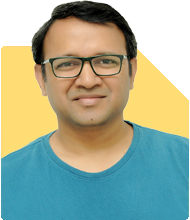65-Year-Old Retiree with No Pension: How to Generate Rs. 50,000 Monthly Income?
Ramalingam Kalirajan |10899 Answers |Ask -Follow
Mutual Funds, Financial Planning Expert - Answered on Dec 07, 2024
He has an MBA in finance from the University of Madras and is a certified financial planner.
He is the director and chief financial planner at Holistic Investment, a Chennai-based firm that offers financial planning and wealth management advice.... more

I am 65 year age retired and have no pension. I have made investment in few govt schemes and get some regular income by way of interest but due to inflation and low interest rates scenario emerging pl suggest basket of investment to get regular monthly income of Rs 50000 . I have handsome amount in ppf account which is about to mature
Steps to Achieve Rs. 50,000 Monthly Income
1. Reassess Your Current Investments
Evaluate the performance of your government schemes and compare their returns.
Retain investments offering guaranteed and steady income, like Senior Citizen Savings Scheme (SCSS) or Post Office Monthly Income Scheme (POMIS).
Redeploy funds from low-yield investments to more productive avenues.
2. Utilise the Maturing PPF
PPF offers tax-free corpus. Use this to create a diversified portfolio for stable income and growth.
Split the PPF corpus into equity mutual funds and safer debt instruments.
3. Diversify with Debt and Hybrid Funds
Invest in conservative hybrid funds to generate regular income and protect capital.
Include short-term and medium-term debt funds for steady returns, which are higher than fixed deposits.
4. Set Up a Systematic Withdrawal Plan (SWP)
Use equity or hybrid mutual funds to set up SWPs.
An SWP ensures a steady monthly income while your capital continues to grow.
5. Consider Dividend-Yielding Funds
Dividend-paying mutual funds offer periodic cash flow and potential for capital appreciation.
6. Fixed Income Instruments for Safety
SCSS: Offers assured returns and is tailor-made for senior citizens. Invest up to Rs. 30 lakh as a couple.
POMIS: Provides reliable income for smaller investments.
7. Include Tax-Free Bonds
Invest in high-quality tax-free bonds for steady, tax-efficient interest.
Creating the Income Plan
To achieve Rs. 50,000 per month:
Allocate a portion of funds to safer options like SCSS, POMIS, and tax-free bonds for stability.
Use equity and hybrid funds for growth and inflation protection.
Combine these with SWPs for regular income.
Tax Planning
Interest from SCSS and POMIS is taxable, so invest carefully.
Equity mutual funds have tax-efficient withdrawal options.
Debt funds offer indexation benefits for long-term investments.
Emergency and Health Fund
Keep at least 12 months of expenses in a liquid fund for emergencies.
Maintain your health insurance to handle rising medical costs.
Final Insight
A mix of secure instruments, mutual funds, and systematic withdrawals can comfortably generate Rs. 50,000 monthly income. Periodically review your plan with a Certified Financial Planner to adapt to changing needs and market conditions.
Best Regards,
K. Ramalingam, MBA, CFP,
Chief Financial Planner,
www.holisticinvestment.in
https://www.youtube.com/@HolisticInvestment
You may like to see similar questions and answers below
Ramalingam Kalirajan |10899 Answers |Ask -Follow
Mutual Funds, Financial Planning Expert - Answered on Jun 06, 2024
Ramalingam Kalirajan |10899 Answers |Ask -Follow
Mutual Funds, Financial Planning Expert - Answered on Jun 04, 2024
Vivek Lala |323 Answers |Ask -Follow
Tax, MF Expert - Answered on Jun 24, 2024
Ramalingam Kalirajan |10899 Answers |Ask -Follow
Mutual Funds, Financial Planning Expert - Answered on Jul 10, 2024
Ramalingam Kalirajan |10899 Answers |Ask -Follow
Mutual Funds, Financial Planning Expert - Answered on Feb 10, 2025
Ramalingam Kalirajan |10899 Answers |Ask -Follow
Mutual Funds, Financial Planning Expert - Answered on Dec 17, 2025
Ramalingam Kalirajan |10899 Answers |Ask -Follow
Mutual Funds, Financial Planning Expert - Answered on Dec 17, 2025
Ramalingam Kalirajan |10899 Answers |Ask -Follow
Mutual Funds, Financial Planning Expert - Answered on Dec 17, 2025
Ramalingam Kalirajan |10899 Answers |Ask -Follow
Mutual Funds, Financial Planning Expert - Answered on Dec 17, 2025
Ramalingam Kalirajan |10899 Answers |Ask -Follow
Mutual Funds, Financial Planning Expert - Answered on Dec 17, 2025
Mayank Chandel |2576 Answers |Ask -Follow
IIT-JEE, NEET-UG, SAT, CLAT, CA, CS Exam Expert - Answered on Dec 17, 2025
Radheshyam Zanwar |6747 Answers |Ask -Follow
MHT-CET, IIT-JEE, NEET-UG Expert - Answered on Dec 16, 2025
Shalini Singh |181 Answers |Ask -Follow
Dating Coach - Answered on Dec 16, 2025
Patrick Dsouza |1429 Answers |Ask -Follow
CAT, XAT, CMAT, CET Expert - Answered on Dec 16, 2025
Nayagam P P |10858 Answers |Ask -Follow
Career Counsellor - Answered on Dec 16, 2025




























